
Morimoto Asia Omakase: Fine Dining At Its Best
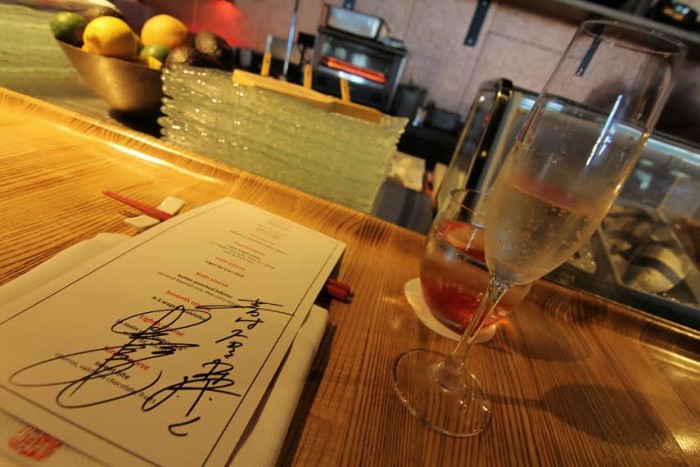 A few weeks ago, Morimoto Asia hosted their first omakase dinner led by Iron Chef Morimoto himself, and I was lucky enough to attend! An omakase meal is pretty simple – the chef makes all of the decisions for you, setting the menu as they desire (though sometimes customization is an option). California Grill offers an omakase dining option at their sushi bar, and it’s widely considered one of the best dining splurges at Walt Disney World. This particular opportunity, though, seemed even more special than that, as Chef Morimoto would be working alongside his team at Morimoto Asia – a rare chance to see one of the masters in action. I was excited for this meal, especially given the excellent meals I’d had here before (and Len’s great review of most of the menu).
A few weeks ago, Morimoto Asia hosted their first omakase dinner led by Iron Chef Morimoto himself, and I was lucky enough to attend! An omakase meal is pretty simple – the chef makes all of the decisions for you, setting the menu as they desire (though sometimes customization is an option). California Grill offers an omakase dining option at their sushi bar, and it’s widely considered one of the best dining splurges at Walt Disney World. This particular opportunity, though, seemed even more special than that, as Chef Morimoto would be working alongside his team at Morimoto Asia – a rare chance to see one of the masters in action. I was excited for this meal, especially given the excellent meals I’d had here before (and Len’s great review of most of the menu).
Before The Meal
I arrived not knowing exactly what to expect, other than that every bit of chopstick and sushi etiquette I’d ever learned would be put to the test. The dinner was offered to only 12 diners, and we were seated in waves to make it easier on the chefs to time the meal. I was in the first wave of four to arrive, and we were immediately seated at the beautiful sushi bar on the upper level of the restaurant. Chef Morimoto and Morimoto Asia’s executive chef, Yuhi Fujinaga, were already engaged in a precise dance of preparation for our first few courses, working alongside four other chefs, ensuring every dice was to their exact specifications. After a few minutes of watching them all, I knew I was in for a special evening.
Every diner received a Chef Morimoto-signed menu for the evening listing all of the nine (!!!) courses to come as we sat down to the sushi bar, where we were also told that we could opt to include alcohol pairings with each course. Obviously, I had to take one for the team (in the name of research, of course!), and give the pairings a shot. Below, I’ll outline each course as presented and the pairings that came with them, with a few thoughts on each. As always, take a closer look of each dish with just a click on any photo.
The Main Event
First Course: Oyster Two Ways – caviar, foie gras
Paired with Jean Charles ‘JCB no21’ Cremant de Bourgogne, Burgundy, France
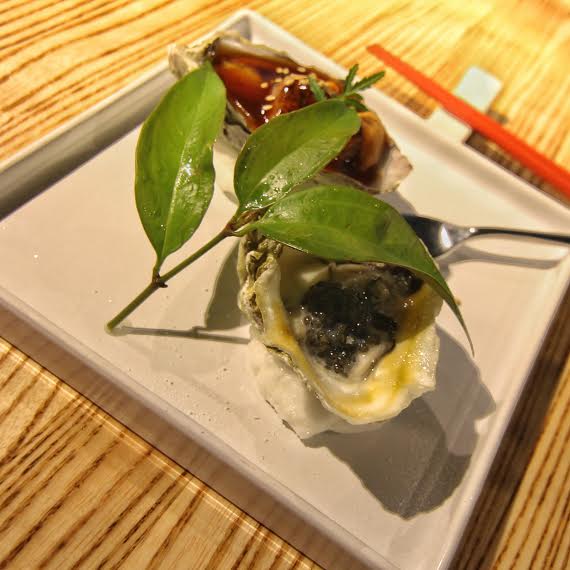 This starter was the perfect exercise in how hot & cold temperatures can work together to create a cohesive dish. One oyster was served cold topped with caviar, and the second, topped with freshly seared foie gras swimming in an umami-rich teriyaki sauce. My first bite, of the cold oyster, was as briny and of-the-sea as you’d expect, and refreshing to wake up the palate. The decadent foie gras was slightly sweet in my follow-up bite of the second oyster, helping soothe a bit of the first’s saltiness. The bubbly JCB Cremant, shown above with the menu, really offset both oysters perfectly with a bit of acidity.
This starter was the perfect exercise in how hot & cold temperatures can work together to create a cohesive dish. One oyster was served cold topped with caviar, and the second, topped with freshly seared foie gras swimming in an umami-rich teriyaki sauce. My first bite, of the cold oyster, was as briny and of-the-sea as you’d expect, and refreshing to wake up the palate. The decadent foie gras was slightly sweet in my follow-up bite of the second oyster, helping soothe a bit of the first’s saltiness. The bubbly JCB Cremant, shown above with the menu, really offset both oysters perfectly with a bit of acidity.
Second Course: Tartare Two Ways – toro, A-5 wagyu
Paired with Cerulli Spinozzi ‘Cortalto’ Pecorino, Abruzzo, Italy
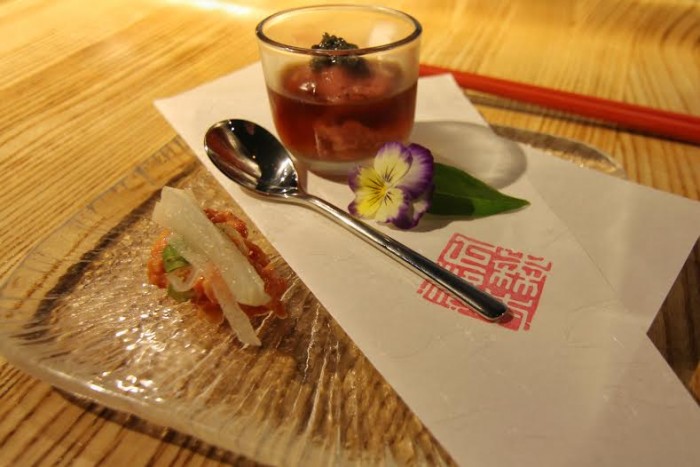 Similar to the first dish, this second course played on the duo theme with a tuna tartare served in a dashi soy sauce alongside A-5 (the highest quality available) wagyu beef tartare. Chef Morimoto hand-chopped the beef in front of us, before mixing it with a bit of spicy aioli, and served the rich beef topped with slightly sweet julienned jicama. The dry and acidic Cortalto wine cut through the richness in both sides of the dish, though I probably could’ve had an entire glass of the dashi soy instead of wine for this course and been happy.
Similar to the first dish, this second course played on the duo theme with a tuna tartare served in a dashi soy sauce alongside A-5 (the highest quality available) wagyu beef tartare. Chef Morimoto hand-chopped the beef in front of us, before mixing it with a bit of spicy aioli, and served the rich beef topped with slightly sweet julienned jicama. The dry and acidic Cortalto wine cut through the richness in both sides of the dish, though I probably could’ve had an entire glass of the dashi soy instead of wine for this course and been happy.
Third Course: Signature Sashimi Caesar Salad
Paired with Cade Winery Sauvignon Blanc, Napa, CA
This dish sounded the most challenging to me at the outset – how would Caesar dressing work with sashimi? Served beautifully, all wrapped up with a gold bow, tons of fresh seafood and seasonal veggies like peppers and snow peas offered a surprising (but great) contrast to the typical, creamy Caesar dressing. The pear-forward Sauvignon Blanc balanced against the natural sweetness of the vegetables and sashimi well, helping to unify an altogether refreshing salad course.
Fourth Course: East Meets West – A-5 wagyu, foie gras, soup dumpling; peking duck taco
Paired with Morimoto Junmai Sake, Ishikawa
By now, it was pretty easy to tell that Chef Morimoto enjoys juxtaposing Western and Eastern-influenced cuisine (especially with the heavily Italian-leaning salad and the very French tartare), but if there had been any doubt left, this dish would’ve thrown it out the window. On the right, I heartily enjoyed a dumpling stuffed to the gills with wagyu and foie gras in a chicken broth soup, bursting with umami and salty flavors, but still surprisingly light. On the left, a decadent Peking duck taco, topped with sweet hoisin and apricot sauces offset by a kiss of fresh lime, brought yet another contrast of flavors and textures in two acts perfectly paired with the light and refreshing junmai sake.
Fifth Course: Nigiri by Iron Chef
Paired with Morimoto Daiginjo Sake, Ishikawa
This course, plain and simple, nearly blew my face off. Chef Morimoto was very keen to give us all a quick lesson on sushi etiquette while he was preparing the nigiri (basic tips like: eat it with your hands, never mix your wasabi with your soy sauce, immediately eat the sushi to avoid quality degradation, and use the pickled ginger only as a palate cleanser). He even explained the differences in the dark and light soy sauces that came with different pieces (dark soy with fattier tuna, but light soy with white fish).
We started with less-fatty tuna (chutoro), then otoro (creamy, buttery, incredibly rich tuna), octopus (briny from the sea salt and lemon juice freshly squeezed on top), and finally a lovely piece of eel and avocado served on a square of nori, topped by eel sauce. I love the sweetness of eel and eel sauce, so this was my favorite, and I thought it was the best offset for the apple and citrus-heavy daiginjo sake. The nigiri itself was incredible, and Chef Morimoto insisted on making more for us if we were all still hungry, but watching him make each piece might have been the highlight of my meal, even aside from the taste.
Sixth Course: Butter Poached Lobster – coconut basmati rice, thai curry espuma
Paired with Tentaka Kuni ‘Hawk in the Heavens’ Junmai Sake
I thought, by this point, that the sushi would be the apex of the meal, and everything else would be great, but not quite that great. Then Chef Yuhi came out from the back kitchen stirring the coconut milk 60%-polished basmati rice “risotto” that he’d prepared for the base of this fish course – I instantly knew by the intoxicating smell emanating from the pot that I was wrong. Continuing the east meets west theme, Chef Morimoto paired this risotto with three gorgeous pieces of butter poached lobster (as sweet and delicate as could be) and an absolutely addictive Thai curry foam.
The earthiness of the spices in the curry sauce offset the rich risotto and lobster so well, never overpowering either’s mild flavors, but pushing the dish further down the savory spectrum and grounding it a bit. Though this was the largest portioned dish we’d had so far, it definitely did not feel heavy at all. The sweet ‘Hawk in the Heavens’ junmai played with the lobster’s flavor swimmingly – just as with the raw fish preparations we’d had before, the sake never overpowered the mild natural seafood flavors.
Seventh Course: A-5 Wagyu ‘Yakiniku’
Paired with Kikusakari Tarusake Cedar Aged Sake
Just when we thought we’d seen the best, Chefs Morimoto and D. Alex started carving the massive wagyu portion, slicing portions to prepare yakiniku style – grilled to order right in front of us. Served alongside a sweet garlic soy buri-bop sauce (the same ridiculously great sauce you can taste on the buri-bop bowl on the regular menu) and a chimichurri (east meets west again!), the wagyu was predictably rich and decadent, tender, but also very flavorful, even for such thin slices.
The tartare course earlier had highlighted the richness of the beef, but this hot preparation really allowed the flavor given to the meat by all of its fat to shine – I now understand why A-5 wagyu is held in such high regard. I’d encountered American Kobe beef and even wagyu before, but it was nowhere near this good – a testament to the quality given such a simple preparation. The smoky cedar aged sake was a lovely treat alongside this dish – sweetness on the front end cut through the savory flavors from the beef and sauces. The spiciness that hit on the back of the throat after my first few sips gave the sake an unexpected complexity – it was almost like drinking a well-made bourbon cocktail.
Eighth Course: Lo Mein Uni “Carbonara” – quail egg, bacon
Paired with Evoluzione Crazy Milk Nigori
The pasta course was the true culmination of all of the Italian influences so heavily seen in previous dishes – Chef Morimoto made an exact replica of a typical pasta carbonara’s flavor, but with quintessentially Japanese ingredients. Lo mein noodles and segments of uni (sea urchin roe) were topped with a cream, butter, and bacon foam and a tiny, perfectly runny quail egg combining forces to create the correctly textured and flavored carbonara sauce. The brininess and richness of the sea urchin salted the smoky and creamy foam sauce, with textural crunch coming from a few bites of bacon on top of it all.
I really can’t explain how remarkable this dish was to me; if you closed your eyes, you’d think you were eating at a top Italian restaurant – that’s how close the flavor was to a real carbonara dish. The even more remarkable part, though, was watching the five master chefs working at the counter (Chef Morimoto included) to plate this one dish for each of us – every component had such care and precision taken with it that it was hard to believe it was all gone within a few short minutes. The unfiltered sake served alongside this dish was much sweeter than the others we’d sampled, reminiscent of a Pinot Grigio you’d pair this dish with in a typical Italian eatery.
Ninth Course: Sweet Bite – churros, valrhona chocolate, fruits
Paired with Korean black raspberry dessert wine
Finally, I’d made it to dessert (though the previous three courses had elevated me to a different plane of existence, truthfully). Here, we saw a trio – Morimoto Asia’s signature churros (yes, churros) and a tiny cup of chocolate espresso (a very rich sauce that was drinkable but also perfect for churro dipping) sat next to the true star, local watermelon that had been compressed, marinated with lychees, and then caramelized with plum vinegar. Fruit desserts aren’t my typical go-to anywhere, but the pure sweetness of the watermelon was just sublime – the compression takes the water out and allows the actual flavor to come through much stronger. Add to that the slight acidity from the plum vinegar and the savory notes from the caramelization on top, and it really was the perfectly balanced bite to end our meal.
Final Thoughts
At the beginning of my meal, my server had said that it was very rare for Chef Morimoto to actually hold an omakase meal – he’d only prepared meals like this open to the public for a few dozen people over the years. After watching the chefs dance for two hours to prepare these remarkable dishes, I could see why it happened so rarely, but I was certainly glad I was there to be a part of it. Chef Morimoto was so animated and passionate about each dish, but just as interested in speaking to all of us and answering our questions as he was in actually cooking for us.
By the time we hit the fifth course, I was interested why he had so much Italian influence in his menu that night – was it just what he was feeling at the moment, or was there something larger at play? He first jokingly answered that his mother is full-blooded Italian, but then gave a really great response – both Italian and Japanese cuisines make the most of fresh and local ingredients available and at their best on the day, with preparations using only the basics of oils, salt, and pepper. The raw ingredients are able to shine through because of this simplicity, in contrast to the Korean and French cuisines Chef Morimoto also loves and works with, where extracts and aged ingredients tend to reign supreme.
It really hit me at that point that this was probably the most remarkable dining experience I’d ever had – not just because the food was (as expected) phenomenal, but it was as well-thought out and executed as I’d ever seen (including dinners at Victoria & Albert’s, and other great restaurants outside the Disney bubble in big cities all over the world). Without question, if Morimoto Asia ever offers another omakase dinner hosted by Chef Morimoto, I’d go in a heartbeat.
Though I’m not sure many more meals like this particular one will take place, it seems like this was a great launching point for a standard omakase offering at Morimoto Asia (with Chef Yuhi taking lead responsibility as the restaurant’s executive chef). All things considered, if another omakase opportunity or other special events pop up next time you’re near Morimoto Asia, I’d jump at the chance to join in on the fun, even if Chef Morimoto wasn’t going to be there. Obviously the food was spectacular, but the service was even more so, and the attention to detail and care put into each bite by every chef working the dinner was a show unto itself.

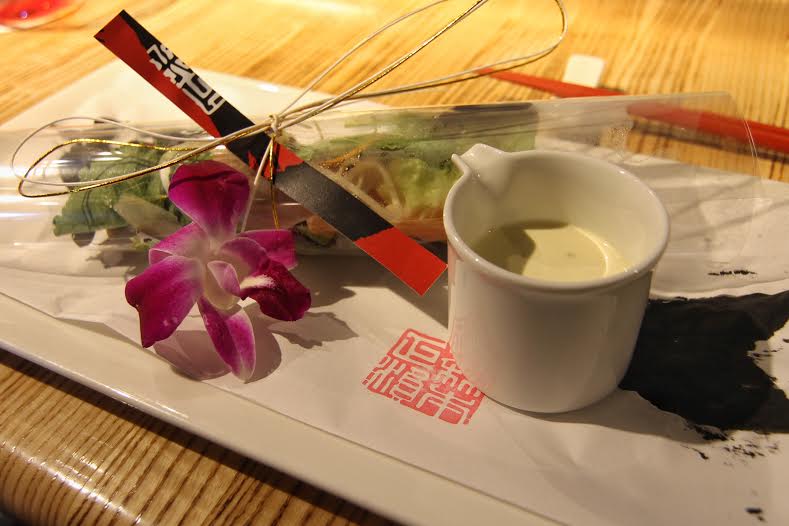

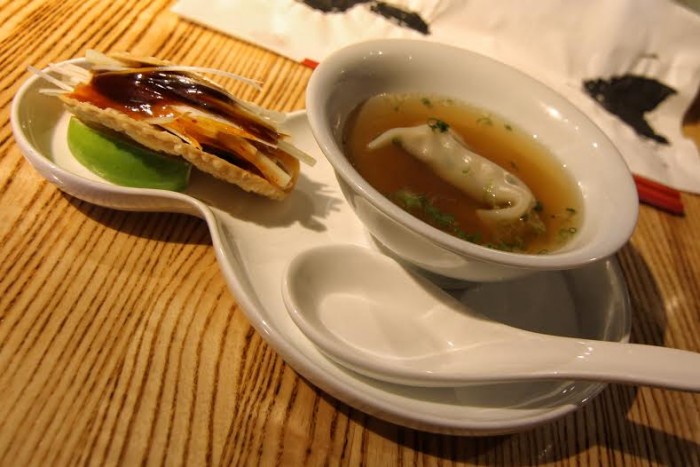
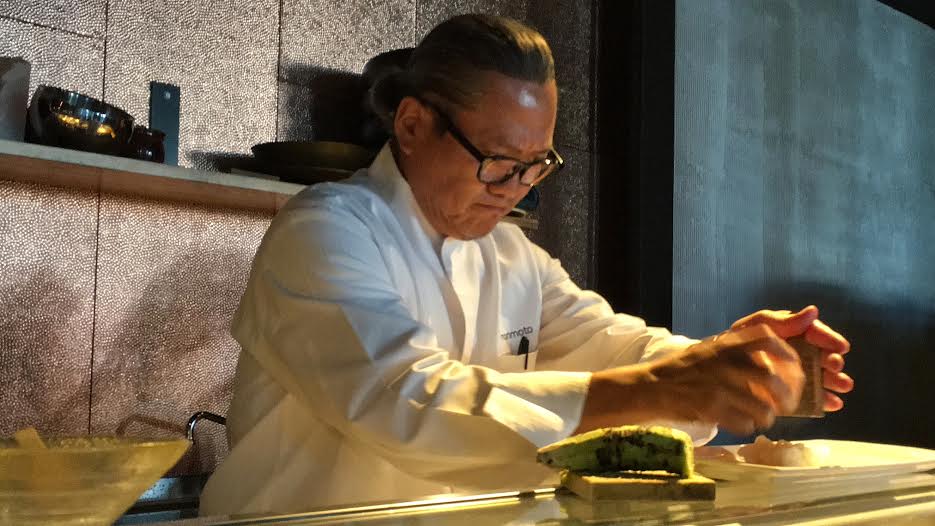
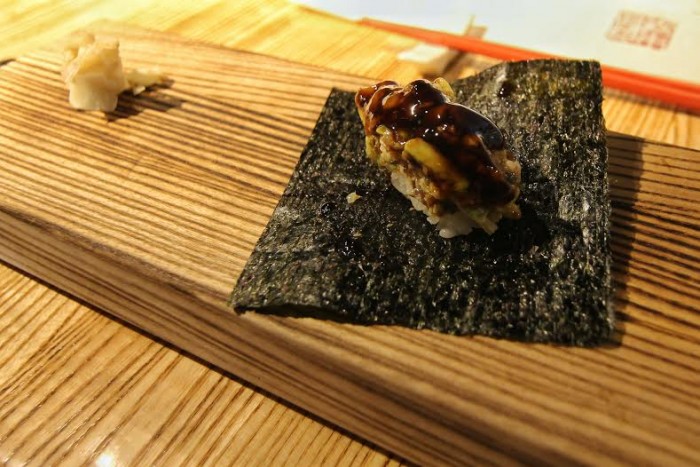

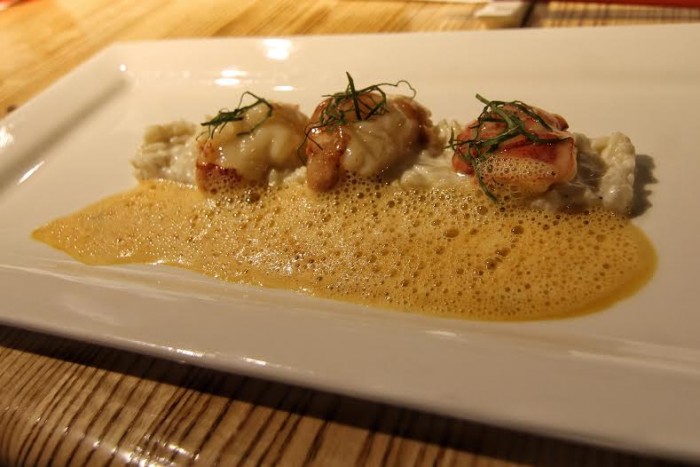

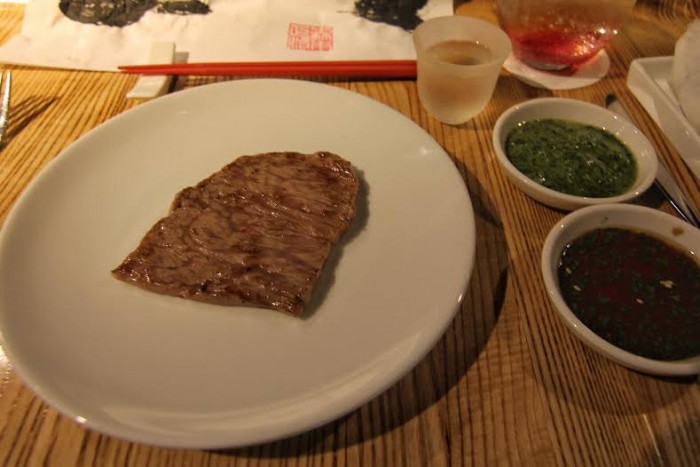







Seems like an absolutely sublime experience. We have been considering the omakase meal for our next visit to Morimoto….if it is half as good as California Grill’s, then it will be fantastic. One thing that is not clear…can the regular omakase experience be booked for any night?
It’s not totally clear to me either, though the page on their site (newly updated!) with the omakase info says yes, any night. I’d confirm when calling to book, but it appears it works like the omakase at other locations – any night, set price, beverage upcharge, must be booked 24 hours in advance. Enjoy!
Would love to know how I can get in on the next one. Also, wasn’t sure if this was a comp’ed meal, or if you paid, but if you paid can you share the price?
Definitely not comped – I put a deposit down when I reserved (info on booking was available on their twitter and facebook pages), but on the night of, I paid $250 for the meal and an upcharge for the alcohol pairings (I believe $75), plus gratuity. I’d expect future omakase meals with Chef Morimoto to run a similar price, but those without him may be a bit cheaper. Certainly a splurge, but comparable in price to other meals I’ve experienced at this level of food/service.
Thanks for the update. And I think that price is totally fair! It seems like a wonderful experience… your post made me want to go so bad. Reminded me of the movie Jiro Dreams of Sushi and how people pay top dollar for that experience.
Thanks for sharing!
We dine anonymously and pay regular price for everything we review, including meals and hotels. If there’s an exception to this – and I can’t think of any off the top of my head – we’d note it in the review.
Thanks! I figured, but I was trying to politely ask about the price. 😉 Appreciate the followup.
How did you get this reservation? Was it open to the general public and you got lucky or was it a media event by invitation to launch a new offering?
Hi Anne – this reservation was open to everyone! I happened to see them post about it on Twitter and Facebook, and responded ASAP.